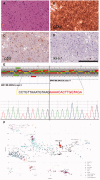A novel ARIH1::BRAF fusion in a glioma
- PMID: 37742132
- PMCID: PMC11009502
- DOI: 10.1093/jnen/nlad074
A novel ARIH1::BRAF fusion in a glioma
Conflict of interest statement
The authors have no duality or conflicts of interest to declare.
Figures


References
MeSH terms
Substances
LinkOut - more resources
Full Text Sources
Medical
Research Materials

